Search results for: 'mit'
-
 Neolithisches Artefakt der Michelsberg-Kultur aus niederländischem Museum
Neolithisches Artefakt der Michelsberg-Kultur aus niederländischem MuseumFund aus 1979 vom Camp-a-Cayaux, bei neolithischer Flintmine in Spiennes, Belgien. 4500 v. Chr. bis 3500 v. Chr. Ex-Museumsstück.
Price: on request Neolithisches Artefakt der Michelsberg-Kultur aus niederländischem Museum
Neolithisches Artefakt der Michelsberg-Kultur aus niederländischem MuseumFund aus 1979 vom Camp-a-Cayaux, bei neolithischer Flintmine in Spiennes, Belgien. 4500 v. Chr. bis 3500 v. Chr. Ex-Museumsstück.
Price: on request Neolithisches Artefakt der Michelsberg-Kultur aus niederländischem Museum
Neolithisches Artefakt der Michelsberg-Kultur aus niederländischem MuseumFund aus 1979 vom Camp-a-Cayaux, bei neolithischer Flintmine in Spiennes, Belgien. 4500 v. Chr. bis 3500 v. Chr. Ex-Museumsstück.
Price: on request Neolithisches Artefakt der Michelsberg-Kultur aus niederländischem Museum
Neolithisches Artefakt der Michelsberg-Kultur aus niederländischem MuseumFund aus 1979 vom Camp-a-Cayaux, bei neolithischer Flintmine in Spiennes, Belgien. 4500 v. Chr. bis 3500 v. Chr. Ex-Museumsstück.
Price: on request Neolithisches Artefakt der Michelsberg-Kultur aus niederländischem Museum
Neolithisches Artefakt der Michelsberg-Kultur aus niederländischem MuseumFund aus 1979 vom Camp-a-Cayaux, bei neolithischer Flintmine in Spiennes, Belgien. 4500 v. Chr. bis 3500 v. Chr. Ex-Museumsstück.
Price: on request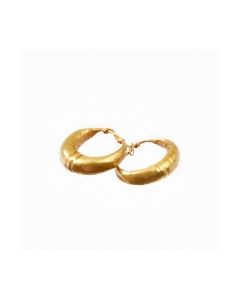 Graeco-Roman earrings
Graeco-Roman earringsThe decorated pair of earrings is made of gold sheet. It is hollow inside. The type is from Northern Africa and dates to Greek or Roman times.
Price: on request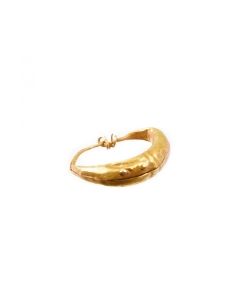 Graeco-Roman earring
Graeco-Roman earringThe decorated earrings is made of gold sheet. It is hollow inside. The type is from Northern Africa and dates to Greek or Roman times.
Price: on request Schmales Dicknackenbeil der Trichterbecherkultur
Schmales Dicknackenbeil der TrichterbecherkulturDer kleine und elegante Beilkopf beeindruckt durch seine gute Erhaltung und ausgewogenen Proportionen. In diesem Zustand absolut museumswürdig! Ganggrabzeit bis Dolchzeit.
Price: on request Großes neolithisches Artefakt der Michelsberg-Kultur aus niederländischem Museum
Großes neolithisches Artefakt der Michelsberg-Kultur aus niederländischem MuseumFund aus 1979 vom Camp-a-Cayaux, bei neolithischer Flintmine in Spiennes, Belgien. 4500 v. Chr. bis 3500 v. Chr. Ex-Museumsstück.
Price: on request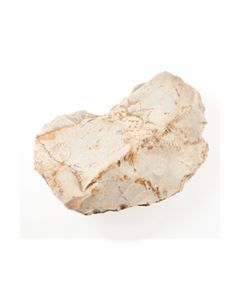 Neolithisches Artefakt der Michelsberg-Kultur aus niederländischem Museum
Neolithisches Artefakt der Michelsberg-Kultur aus niederländischem MuseumFund aus 1979 vom Camp-a-Cayaux, bei neolithischer Flintmine in Spiennes, Belgien. 4500 v. Chr. bis 3500 v. Chr. Ex-Museumsstück.
Price: on request Neolithisches Artefakt der Michelsberg-Kultur aus niederländischem Museum
Neolithisches Artefakt der Michelsberg-Kultur aus niederländischem MuseumFund aus 1979 vom Camp-a-Cayaux, bei neolithischer Flintmine in Spiennes, Belgien. 4500 v. Chr. bis 3500 v. Chr. Ex-Museumsstück.
Price: on request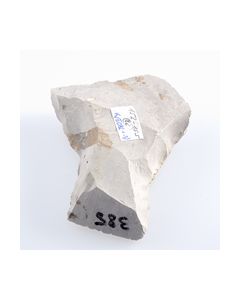 Flachgeschlagenes Beil vom Møn-Typ
Flachgeschlagenes Beil vom Møn-TypFrühes lokaltypisches Beil der Steinzeit in Dänemark. 5400 v. Chr. bis 4000 v. Chr., Spätmesolithikum, Ertebølle-Ellerbek-Kultur. Toller weißer Stein.
Price: on request Head of Isis - found 1963 at Ras-el-Tin Necropolis, Alexandria
Head of Isis - found 1963 at Ras-el-Tin Necropolis, AlexandriaPtolemaic till Roman Egypt, worked with high level of details and very nicely preserved. From an old German collection.
Price: on request Oil lamp with Amphitheater scene, piece from same workshop exhibited in Getty Museum in LA
Oil lamp with Amphitheater scene, piece from same workshop exhibited in Getty Museum in LAThe mirror scene probably depicts the persecution of Christians in the Roman Empire. Very nicely preserved, from an old US-American collection. Ex Christie's.
Price: on request Mochica stirrup vessel
Mochica stirrup vesselThe body is creatively shaped as a bird man. A wonderful testimony to the last bloom of the Mochica culture before its collapse.
Price: on request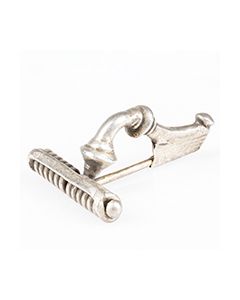 Roman silver fibula
Roman silver fibulaBeautiful brooch from the eastern Roman provinces. Remains of an original gold plating can still be seen on the surface.
Price: on request Cup of the Urnfield culture
Cup of the Urnfield cultureCeramic vessel dating to the transition period between Bronze Age and Iron Age in Central Europe. 1200 to 800 BC. Found in an urnfield in Austria.
Price: on request Ramesside Scarab
Ramesside ScarabEgyptian scarab from the 19th to 20th dynasty. With horse and hieroglyphs.
Price: on request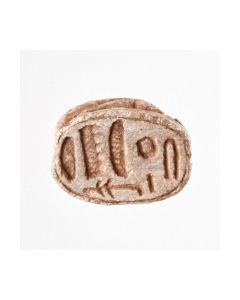 Scarab with inscription
Scarab with inscriptionThe lower side bears a hieroglyph inscription. Nice piece from the Freemark collection. New Kingdom.
Price: on request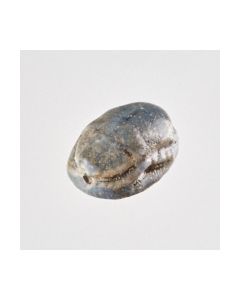 Scarab with blue fayence glaze
Scarab with blue fayence glazeThe piece is from the Third Intermediate Period or the Late Period of ancient Egypt. The inscription refers to Amun-Re, the main god of Theben. The glaze is shining in vivid blue colour.
Price: on request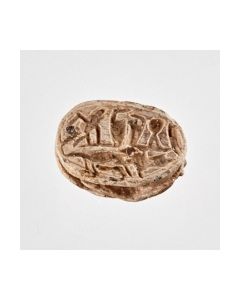 Scarab from the Ramesside period
Scarab from the Ramesside periodThe bottom side shows Horus, Uraeus and crocodile. The crocodile could be interpreted a the god Sobek.
Price: on request Egyptian Scarab with sun beetle
Egyptian Scarab with sun beetleThe scarab amulet from Ramesside times has a beetle engraved in the lower side, flanked by two symbols.
Price: on request Rare massive Bronze Age socketed axe head
Rare massive Bronze Age socketed axe headDieses Tüllenbeil ist durch seine Kompaktheit eine seltene Variante, die einen besonders massiven Eindruck macht und damit für den kraftvollen Arbeitseinsatz geeignet sein dürfte. Interessantes Exemplar aus der späten Bronzezeit Europas.
Price: on request Rare compact socketed axe head
Rare compact socketed axe headSeltene Variante, die einen besonders massiven Eindruck macht und damit für den kraftvollen Arbeitseinsatz geeignet sein dürfte. Interessantes Exemplar aus der späten Bronzezeit Europas.
Price: on request Neolithischer Beilkopf aus Vulkanit
Neolithischer Beilkopf aus VulkanitDünnnackiger, eleganter Rechteckbeilkopf aus einem hartem Vulkangestein. Sehr schwierig zu bearbeiten. Frühneolithikum, 4000 bis 3300 v. Chr.
Price: on request 50 Artefakte der Michelsberger Kultur aus Museumsbestand
50 Artefakte der Michelsberger Kultur aus MuseumsbestandFunde vom Camp-a-Cayaux, bei neolithischer Flintmine in Spiennes, Belgien. Abschläge und Werkzeuge. 4500 v. Chr. bis 3500 v. Chr.
Price: on request Pannonian trumpet brooch
Pannonian trumpet broochWell preserved Roman silver fibula with curved bow. The type is from the Pannonian provinces of Rome and dates to the 2nd century.
Price: on request Pannonian trumpet brooch
Pannonian trumpet broochWell preserved Roman fibula made of silver. The type is from the Pannonian provinces of Rome and dates to the 2nd century.
Price: on request Bronzezeitliches Tüllenbeil
Bronzezeitliches TüllenbeilBeilkopf aus der späten Bronzezeit Mitteleuropas in museumswürdiger Erhaltung. Farbenfrohe Patina. V-förmige Verzierungen auf zwei Seiten. 1000 v. Chr. bis 800 v. Chr.
Price: on request Egyptian amulet of a lion headed goddess
Egyptian amulet of a lion headed goddessAttributed to Sekhmet, goddess of war and protection from illness. Very nice and detailed fayence work. Dating to the Third Intermediate Period to Late Period of Ancient Egypt.
Price: on request Antoninus Pius aureus - reverse extremely fine
Antoninus Pius aureus - reverse extremely finePietas vor brennendem Altar, rechte Hand im Sprechgestus, Linke hält ein Weihrauchgefäß. Eindrucksvolles Stück aus dem 1. Regierungsjahr.
Price: on request Scarab with hieroglyphic formula
Scarab with hieroglyphic formulaThe piece is from the Second Intermediate Period. It was probably meant as a good fortune or protective amulet.
Price: on request Celtic fibula from the famous Hattatt collection
Celtic fibula from the famous Hattatt collectionFibula from the La Tène II period. Found in Celtic Carnuntum. The piece is published in the standard work "Iron Age and Roman Brooches".
Price: on request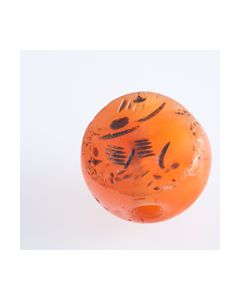 Sassanidisches Stempelsiegel aus orangem Karneol
Sassanidisches Stempelsiegel aus orangem KarneolOrangefarbener Karneol, der Stempel zeigt ein stilisiertes Tiermotiv. Guter Zustand. Inklusive Stempelabdruck. 224 n.Chr. bis 651 n. Chr.
Price: on request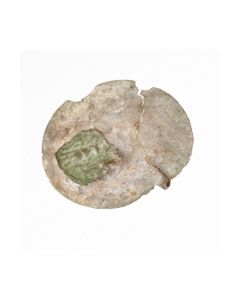 Ancient fibula from the Hattatt collection
Ancient fibula from the Hattatt collectionAncient fibula of the rare adlocutio type. Repoussé work of a scene from a Roman sestertius of Hadrian in celtic style. Find from Dorset in Roman Britain. Published in Hattatts famous book series on ancient fibulae.
Price: on request Tiberius Denarius - Tribute Penny
Tiberius Denarius - Tribute PennyBeautiful, fully centered and almost extremely fine piece.
Price: on request

